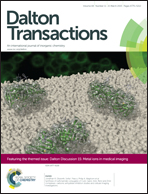Observed hydrolysis of fluorine substituted bis(β-diketonato)-dichlorotitanium(iv) complexes†
Abstract
Novel fluorine substituted mononuclear Ti(β-diketonato)2Cl2 complexes have been synthesised and shown to be involved in a partial hydrolysis reaction in solution, in which the hydrolyzed dinuclear {Ti(β-diketonato)2Cl}2(μ-O) is in equilibrium with the monomer. This is in contrast to the solution behaviour of the non CF3-containing Ti(CH3COCHCOCH3)2Cl2, Ti(PhCOCHCOCH3)2Cl2 and Ti(PhCOCHCOPh)2Cl2 complexes, under the same conditions. Variable temperature (1H and 19F) NMR spectra and X-ray structure analyses reveal that the partially hydrolyzed dinuclear complex exists both in solution and in solid state, bridging through a single μ-oxo bridge and having one labile chloro-ligand per titanium center. Inclusion of electron-withdrawing CF3 groups into the already electron-deficient Ti complexes, led to the formation of {Ti(CF3COCHCOCF3)2Cl}2(μ-O) (dinuclear) and [Ti(CF3COCHCOCF3)2(μ-O)]4 (tetranuclear) complexes in CDCl3 containing trace amounts of water. DFT calculated free energies of hydrolysis support the existence of Ti(CH3COCHCOCH3)2Cl2 as a monomer and Ti(CF3COCHCOCF3)2Cl2 as a equilibrium mixture of the monomer and partially hydrolyzed dinuclear {Ti(β-diketonato)2Cl}2(μ-O) in CDCl3 solution.


 Please wait while we load your content...
Please wait while we load your content...